Subtotal: $
Checkout-

Behind Prison Walls
-

Womb to Tomb
-

Insights on the Gospel of Life
-

A World Where Abortion Is Unthinkable
-

Gardening with Guns
-

A Good Death
-

Behold the Glory of Pigs
-

Polyface Logic
-

Nature Is Sacred Stuff
-

Editors’ Picks Issue 10
-

Poem: An Apology for Vivian
-

Stewarding Mercy
-

Learning to Love Goodness
-

Who Invented Thirst and Water?
-

Muhammad Ali
-

Are Humans Sacred?
-

Islands
-

Readers Respond Issue 10
-

Consistent Life Network
-

Death Knell for Just War
-

Remembering Daniel Berrigan
-

My Return to Iraq
-

Pursuing Happiness
-

The Gospel of Life

Next Article:
Explore Other Articles:
Shane Claiborne, the well-known activist and author, wants “a Christianity that looks like Jesus.” His Simple Way community in Philadelphia’s Kensington neighborhood seeks to live out the revolutionary vision of the Sermon on the Mount: peacemaking, racial reconciliation, and a life rich in relationships instead of possessions.
Plough asked Shane what he’s learned about communal living, how marriage has changed him, why millennials are leaving Christianity, and his newest mission: abolishing the death penalty.
Already a subscriber? Sign in
Try 3 months of unlimited access. Start your FREE TRIAL today. Cancel anytime.
Peter: Shane, you and I are speaking together outside the US Supreme Court building, where you’re part of a four-day vigil calling for an end to capital punishment. That’s also the focus of your latest book, Executing Grace, which argues that abolition should be a priority for US Christians. Why this issue now?
Shane: When some people hear me say “death penalty” they go, “Ooh, sounds like debate class in high school!” I get that. But what sets this issue apart – what makes it so disturbing – is that we Christians are the biggest champions of executions in this country. In fact, the regions where the death penalty has flourished are precisely the areas where Christians are most concentrated. Eighty-five percent of all executions since 1976 have happened in the Bible belt. Other studies confirm that the group that supports capital punishment most fervently is evangelical Christians – much more so than secular people.
For followers of Jesus, other life issues, including abortion, remain very important. But what’s unique about the death penalty in the United States is that we Christians own it. Without our support, it probably would no longer exist.
Why do Christians love the death penalty?
There are many reasons. But the most troubling one stems from a fundamental misunderstanding of why Jesus died. Since I started talking about this issue, I have gotten emails from people asking, “How can God be against the death penalty when God used it to save humanity through Jesus’ execution?” So Jesus’ death is used as a reason to kill people.
As you point out, the early Christians would have been appalled at that kind of thinking.
The Christians of the first three centuries had a consistent ethic of life – they spoke out against all killing, without exception, including war, abortion, and the death penalty. They asked: Why do we call it murder when one person kills another in private life, but call it killing if it’s done in war or through execution? Two thousand years ago they were already naming these contradictions.
An overwhelming majority of Americans actually know this. In a recent Pew poll that asked people whether Jesus would support the death penalty, only 5 percent said yes.
Your book discusses the history of American racial violence, particularly of lynching. What’s the link between this history and the death penalty today?
A lot of the new research was initiated by Bryan Stevenson, a lawyer and founder of the Equal Justice Initiative in Alabama. He’s found that it’s exactly the places where lynchings were carried out a hundred years ago in which the death penalty flourishes today, in states like Texas, Georgia, Florida, and Alabama. Obviously, there’s a complicated story here. Yet there does seem to be continuity between lynching – which, let’s remember, often involved torture, mutilation, and burning in front of audiences of thousands – and what the Equal Justice Report calls “a more palatable form of violence” in the form of the death penalty after World War II. In 1950, African Americans made up 22 percent of the population but 75 percent of those executed. Today, African Americans are 12 percent of the population, yet make up 34 percent of folks executed and almost half (43 percent) of those on death row.
Writers like Michelle Alexander and Ta-Nehisi Coates have highlighted the massive racial disparities in the US criminal justice system, which affect millions. Meanwhile, conservatives like Heather MacDonald point out that for young African-American males, the greatest risk of being killed is through violent crime. With these problems unresolved, is focusing on the death penalty a distraction?
The death penalty is a gateway to talking about the broader issues of racial justice, because what’s true for capital punishment is true for them too. For instance, statistically the biggest determinant for who gets executed is not the atrocity of the crime but the race of the victim. When the victim is white and the defendant is a person of color, he or she has a much higher chance first of being sentenced to death, and then of actually being executed.
One in three African-American boys born today can expect to go to prison. This has everything to do with our history: we haven’t spoken the truth about slavery and racism, and we haven’t done the necessary work of repentance and reconciliation. The United States accounts for 5 percent of the global population but 25 percent of the world’s prisoners. There are more people of color in US prisons today than there were slaves in 1850. Slavery did not end, it just evolved.
These facts should cause us all to stop. In recent years, 156 folks have been released from death row after proving their innocence. In most cases, these exonerations only happened because of the work of students, volunteers, activists, and nonprofits. It’s not the case that the criminal justice system is working.
But don’t the victims’ families deserve justice too?
Yes, and that is why I start my book by telling about the victims of violence. These murder victims’ families are heroes of mine, people like SueZann Bosler. She and her dad, a pastor, were attacked by a church intruder who killed her father and almost killed her. At the trial, when given the chance to make a statement, she spoke against the death penalty. Despite the fact that she was the crime victim, the judge silenced her and actually threatened to hold her in contempt of court, with the chance of a fine or jail time. Voices like SueZann’s are powerful in reminding us that violence is not the solution to violence. We’ve heard similar messages from families after the Boston Marathon bombing and the shooting at AME Emanuel Church in Charleston.
You’ve called yourself pro-life from womb to tomb. What does that mean?
Whenever we destroy life, we’re working contrary to the Creator – we’re squashing part of God’s image in the world, as Cardinal Bernardin wrote back in 1982 when he called for a “consistent ethic of life.” That means being pro-life from cradle to grave.
It’s unhelpful that the term pro-life has come to mean only anti-abortion. In my neighborhood in Kensington, Philadelphia, to be pro-life means that I’ve got to figure out how to support a fifteen-year-old girl when she gets pregnant. These aren’t just “issues,” they’re human beings.
That’s why I love Mother Teresa so much. She used to say to young women in that situation, “If you don’t know how to handle this, I’ll help you.” It’s not just about picketing abortion clinics, it’s about protecting life by supporting folks in really hard situations.
On June 27, the US Supreme Court dramatically reaffirmed the constitutional right to abortion in the ruling Whole Woman’s Health v. Hellerstedt. How should consistent pro-lifers respond?
When I was in India in the 1990s working with Mother Teresa, I got to know two kids who were basically homeless. So I found a family in the United States that was ready to adopt them. When I asked Mother Teresa about it, though, she was adamant that she didn’t want Indian kids going to the United States so long as our laws continued to make abortion so easy.
For those of us who are pro-life, the current state of affairs really puts a burden of responsibility on us to help bear the weight on people’s shoulders. We need to be helping provide support groups for women who’ve had abortions and for women who are considering abortions. Because abortion has created a sort of national trauma.
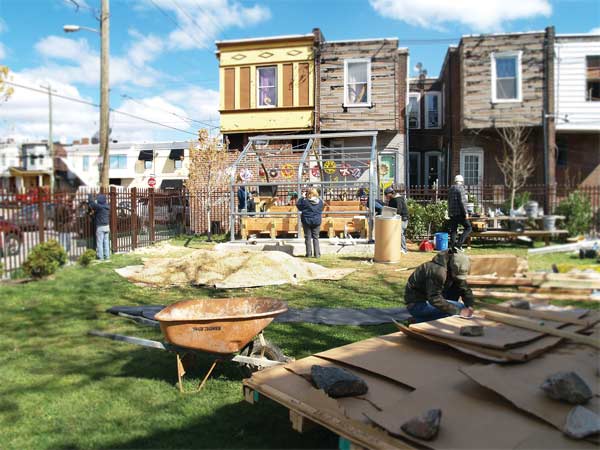
Many willing hands help construct a hydroponic greenhouse in the Simple Way park for local families in the Kensington neighborhood of Philadelphia. Today the greenhouse produces organic vegetables, while the watertank below houses fish whose waste serves as fertilizer.
Photograph by Noir Guy.
Already a subscriber? Sign in
Try 3 months of unlimited access. Start your FREE TRIAL today. Cancel anytime.
Being Bold for the Gospel
Back in 2006, in your book The Irresistible Revolution: Living as an Ordinary Radical, you challenged Christians to “build a movement” inspired by the Sermon on the Mount. A decade later, are there signs of this movement taking shape?
I see that everywhere – a movement of Christians who want Christianity to look like Jesus again, who want to be known not by what we’re against but by what we’re for. In the new 2016 edition of The Irresistible Revolution, I mention many amazing examples of where this stuff is happening, such as my friend Jeremy Courtney in Iraq with the Preemptive Love Coalition, or the folks with the Christian Community Development Association, which is now bigger than it has ever been.
There’s evidence that folks are really longing for community. They’re dissatisfied with a faith that means getting a ticket into heaven while ignoring the world around them, a faith that tells people, “Sorry your life sucks so much now. But you can look forward to life after death!” People ask, “Isn’t there life before death?” They read the Sermon on the Mount and ask: What if Jesus really meant that? Here he tells us to love our enemies, so that probably means don’t kill them. He says not to stockpile for tomorrow while people don’t have enough for today – so what does that tell me about my 401(k) plan?
These questions challenge where our hope lies. As the old hymn goes, “My hope is built on nothing less than Jesus’ blood and righteousness. ... All other ground is sinking sand.” There’s a whole lot of sinking sand, and people are looking for something solid to stand on. What’s beautiful is, we have Jesus as a cornerstone. The wisdom he offered two thousand years ago is just as relevant now as then. When he talks about unjust judges and widows and orphans and vineyard workers that don’t get paid enough, he’s talking about our world too.
Are there parallels here to the Social Gospel movement in the last century? That movement eventually withered because it sidelined the importance of a personal relationship with Jesus.
Too often we in the church separate things that were never meant to be separated. Faith and works have to work together like the two sides of scissors: loving God and loving neighbor are one command. Yes, we do pray, but we also get up off our knees and we go and we work for the things that God cares about.
We’ve got to learn to share about our faith in a way that’s authentic and natural. Do you know the old saying that faith is less of a theory and more of a love affair? I love talking about my wife – so all the more I should love talking about my God and my Savior.
We’ve got to love one person well – we can’t just run programs.
Recently, a friend of mine was talking with denominational leaders who were lamenting that the LGBT issue was going to dissolve their denomination. My friend pointed out that according to a recent study, the average member of their denomination only shared about Jesus with someone else once every five years. He told them, “Actually, if you’re worried about your denomination, that’s what you should be most worried about.”
Folks today haven’t grown up attending Sunday school or reading the Bible – it’s new to them. We’re seeing folks coming and saying, “I’m actually interested in reading the Bible. Tell me about Jesus.”
Jesus tells us not to put our light under a bushel. Let’s shine not for our sake, but because we’re in love with God.
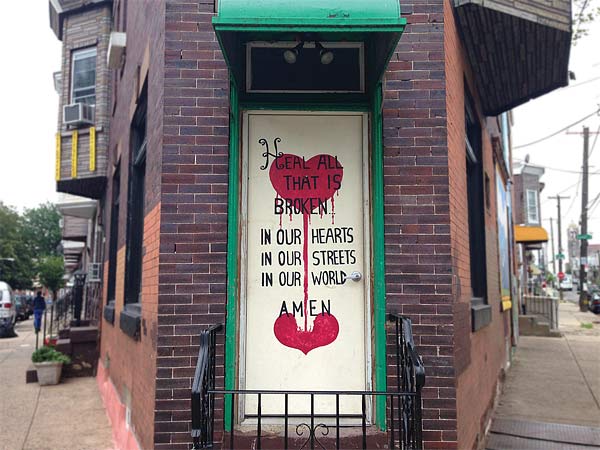
A Simple Way community house.
Photograph from chicagonow.com.
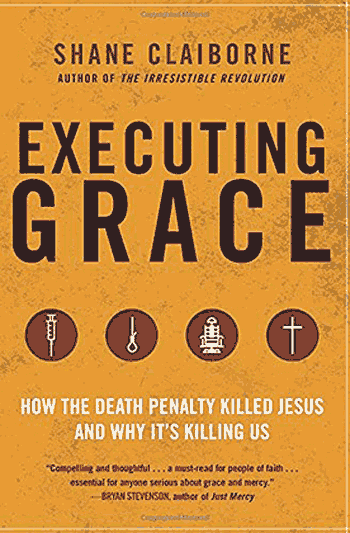 To learn more about the death penalty in the United States and the movement to abolish it, read Shane Claiborne’s book Executing Grace: How the Death Penalty Killed Jesus and Why It’s Killing Us (HarperOne, 2016).
To learn more about the death penalty in the United States and the movement to abolish it, read Shane Claiborne’s book Executing Grace: How the Death Penalty Killed Jesus and Why It’s Killing Us (HarperOne, 2016).
Already a subscriber? Sign in
Try 3 months of unlimited access. Start your FREE TRIAL today. Cancel anytime.
Living in Community
You and Katie Jo just celebrated your fifth wedding anniversary. How have those five years together changed you?
Five years of marriage and we still like each other – we still love each other. It’s funny because in some ways Katie’s a lot more radical than me. When we got married, she said, “We don’t need a microwave, and we don’t need air conditioning. A lot of our neighbors don’t have it, and it’s kind of a privilege.” So we got rid of our microwave and our air conditioning, even though Philadelphia can get to 105 degrees in summer. I’ve learned a trick: you can freeze one of those big water bottles and put it in your bed and it’s your own personal air conditioner at night.
One thing I’ve learned from Katie is that we’ve got to love one person well – we can’t just run programs. She had one young girl that needed a little extra help with school, and she took care of her six hours a day. Someone asked her, “Aren’t there other kids that need help?” And Katie said, “Yes, and that’s why you’re here: to do for one person what you would want to do for everybody.”
We got a tandem bike for our wedding and we rode off on that with the cans rattling behind! We still ride everywhere together.
Your community, the Simple Way, started in 1997 as a communal household. What does it look like today?
We originally moved in with ten people in a row house. Now it’s evolved to about ten properties all in the same neighborhood of Kensington, and we’re aiming to build a kind of village community. Over the years, as a community we’ve been through romanticism and then disenchantment. Now we’re seeking about how to grow old together. How do we continue to love Jesus as passionately as when we were fifteen? And also: How do we get the dishes done? Who changes the oil in the car? We’re still figuring that out.
Are there any mistakes or mis-turns that others can learn from?
We’ve made all kinds of wonderful mistakes over these twenty years. But one thing we did well from the beginning was to say, “We aren’t choosing community, we’re choosing each other.” As Bonhoeffer said, we want not to be in love with our vision for community, but rather to love one another and the people around us. Community grows out of that.
Young people aren’t leaving the church because we’ve made the gospel too hard but because we’ve made it too easy.
When people come to the Simple Way thinking they’re going to see fifteen people living together perfectly in this little drop of heaven on earth, yes, they’re disappointed. But what’s just as common is that people come away from visiting the Simple Way saying, “Wow, we can do this too! It’s not that spectacular.”
We’ve got our share of lumps and bruises. In the end, my interest isn’t in people doing what the Simple Way does. My interest is that they should be who God made them to be and to find community in whatever form that takes. Ultimately, that means to fall in love with Jesus.
What day-to-day practices in communal living have become especially important to you?
In our early years, we picked up some important tools by visiting your community, the Bruderhof. One tool we learned from you was to create a culture where confession comes naturally – to make a space for people to say “I’m sorry.” The idea of confession and repentance is very countercultural in our world.
Another tool we learned from the Bruderhof is the importance of straight talk: being able to talk directly to each other as Jesus tells us to in Mathew 18. That’s something we always have to keep getting back to. In his monastic rule, Saint Benedict warned against “murmuring,” by which he meant talking negatively about each other, which creates an environment that’s toxic for community.
Communities like ours and yours are really like cells of the body. Cells are born and cells die, but the body lives. The great thing about having a community of communities, a body with cells, is that we can help each other out. What we do have in common is a focus on Jesus and the Sermon on the Mount. That’s the lens through which we can understand Scripture and understand the world that we live in.
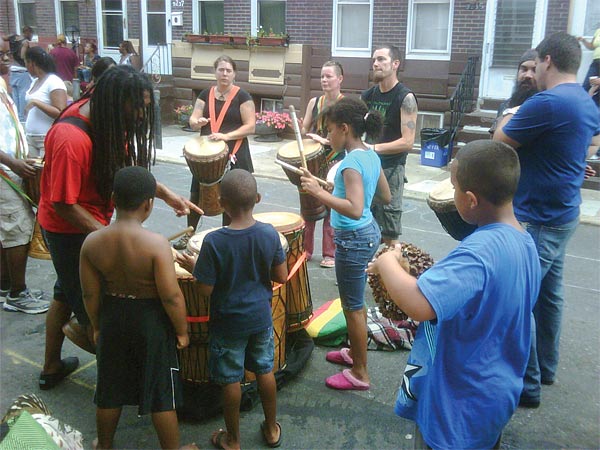
Mentoring neighborhood children is one of the Simple Way’s main ministries.
Photograph by Noir Guy.
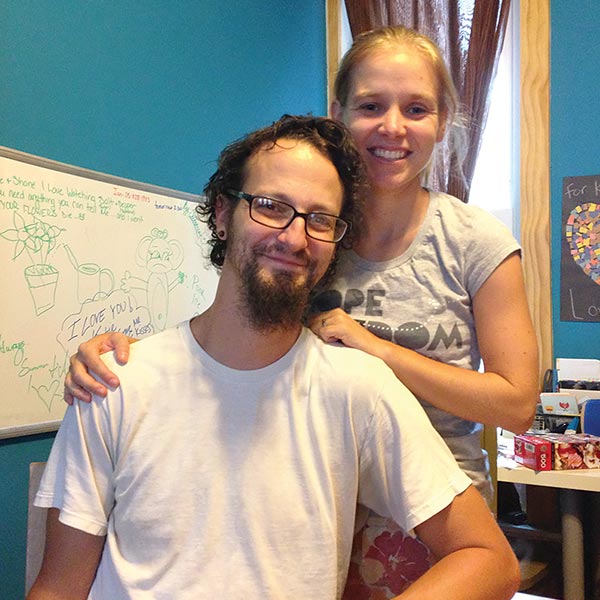 Shane with his wife, Katie Jo, who runs an afterschool program out of their home.
Shane with his wife, Katie Jo, who runs an afterschool program out of their home. Photograph from chicagonow.com.
Already a subscriber? Sign in
Try 3 months of unlimited access. Start your FREE TRIAL today. Cancel anytime.
Past Church, Future Church
Several newer Christian communities call themselves “new monastics,” and the Simple Way has been called that as well. Are you a monastic?
When we started a community and folks started calling it monasticism, I joked that some of my neighbors would be like, “I know you’re kind of nasty, but monasty?” So “new monasticism” is not language that I use in my neighborhood necessarily.
But what is helpful about language is that it connects us to history and it gives us the humility to realize that what we’re doing has been done before. The spirit of the desert monastics in the third and fourth centuries can help us. Sister Margaret, one of my mentors and an eighty-year-old Medical Mission sister, says that the inner city is the contemporary desert. It’s where we go to find God and where demons and angels are at war. The Desert Fathers and Mothers loved God with a single-mindedness – that’s where the mono of monasticism comes from.
Through the centuries, the purity of the gospel has often become so watered down by the narcissistic gospel of prosperity and by the war gospel. We who want the gospel of Jesus need examples from the past, and the monastic tradition is one of them. We have so much to learn from communities, like the Bruderhof, that have been around for generations and are still full of vitality. We can learn from the historic black church in this country, from Oscar Romero and the Jesuits in El Salvador, from the civil rights movement, from John and Vera Mae Perkins. The more diverse our cloud of witnesses, the better off we are.
We’ve spoken about history, but what about the future? Many Christians are worried about “the rise of the nones” – the growing number of young people who say they have no religious affiliation.
I’m convinced that a lot of young people aren’t leaving the church because we’ve made the gospel too hard but because we’ve made it too easy. We’ve thought that young people want to be entertained with louder worship music and fun youth nights with blow-up sumo dolls.
Now, young people might come for that, but they’re not going to stay because of that. They’ll stay because we’ve given them a vision for God’s kingdom coming on earth. They’ll stay because of a gospel that challenges them to dive into the deep darkness of our world where people have been forsaken. They’ll stay because Jesus dares us to be as courageous for the cross as we’ve been for the sword.
Interview by Peter Mommsen on June 30, 2016.
Already a subscriber? Sign in
Try 3 months of unlimited access. Start your FREE TRIAL today. Cancel anytime.



































J Longton
When Jesus was dying, he was crucified with 2 other men. Why didn't he tell the centurions to repent, and not carry out the death penalty?
Paul White
Back in the late 1960s, a white friend of mine was pulled over for a traffic violation. The police smelled marijuana and searched his car. They found sixty pounds of the drug in the trunk of his car. Later that year, an African-American acquaintance of mine who was active in the civil rights struggle was also pulled over. The police claimed they found the remains of a marijuana joint on the floor of his car. Sixty pounds vs part of a joint. Can you guess which man spent the longest time in jail? I'm sure you got it right. My white buddy got 90 days but was out in 45 for good behavior, my black friend got over a year with no early release.
MICHAEL NACRELLI
I don't know any Christians who "love" the death penalty, but the Bible clearly doesn't regard it as murder. (See Gen. 9:6 & Rom. 13:4.) It can't be compared to the state-sanctioned slaughter of over a million innocent unborn babies in the US every year. Christians "own" this travesty in that we've become numb to it and allowed to continue unabated for so long. If the Democrats succeed in overturning the Hyde Amendment restricts federal funding of elective abortion, then we'll have even more blood on our hands.